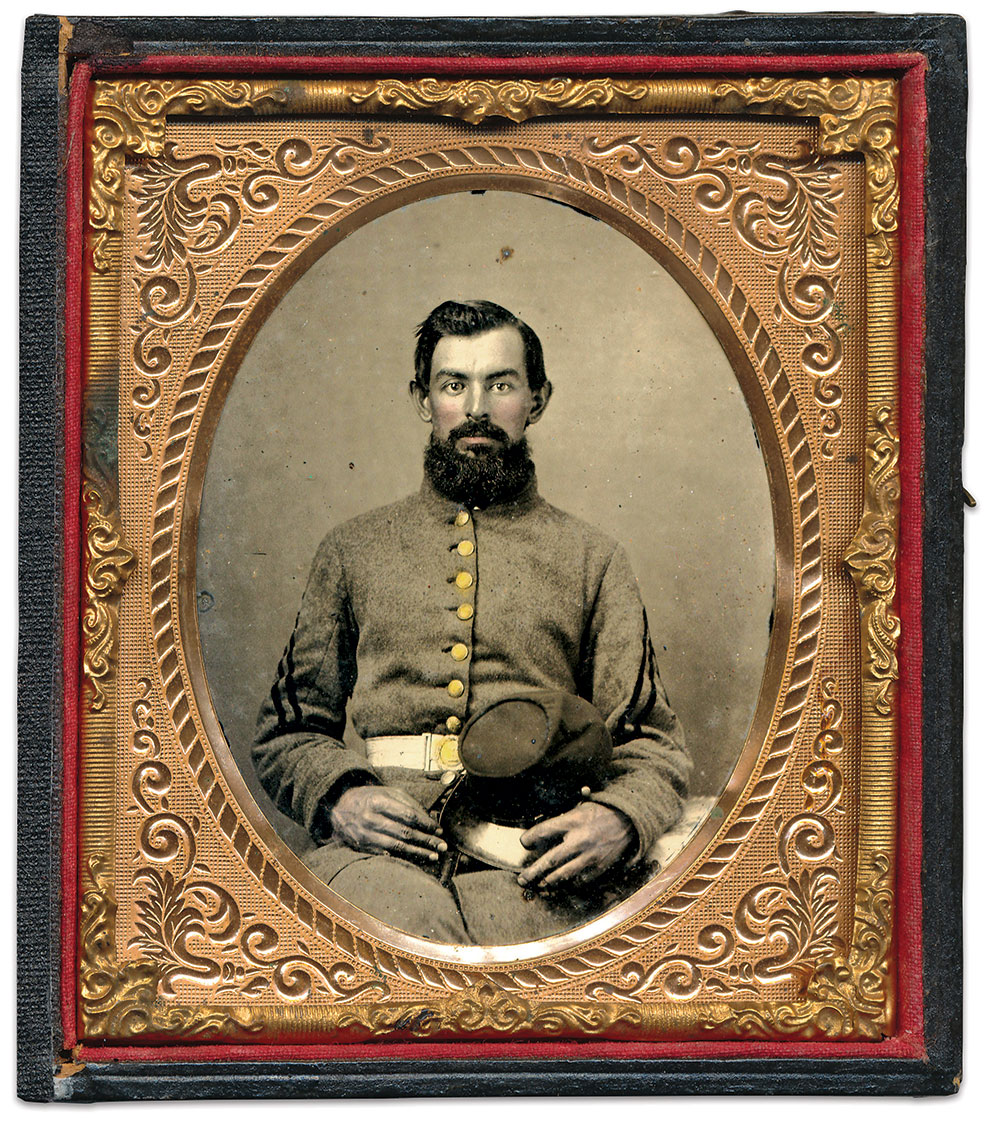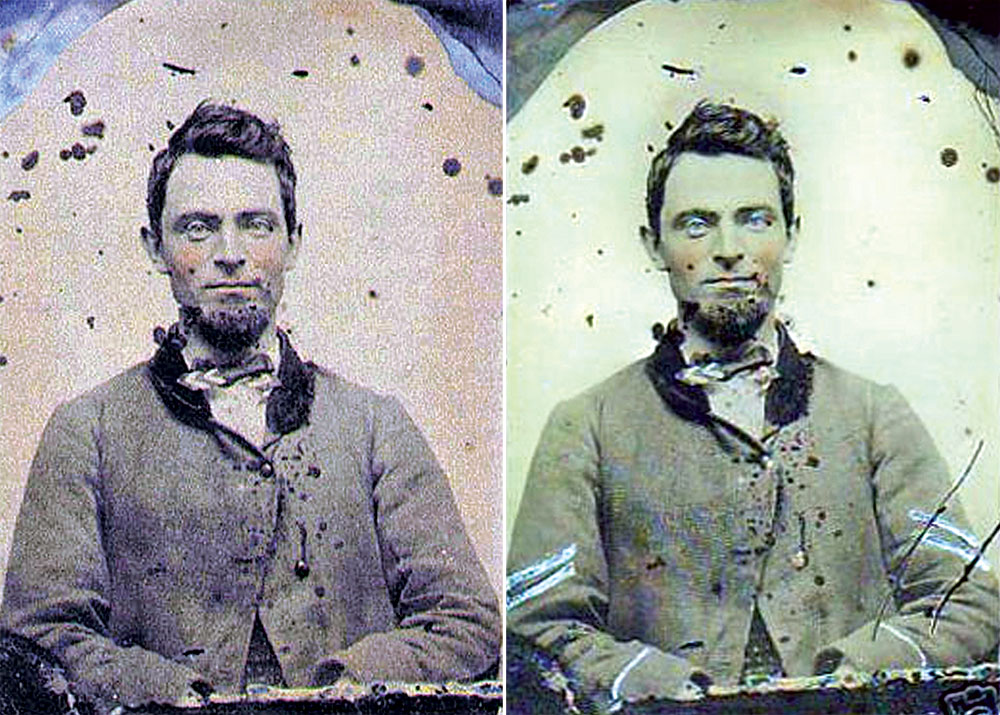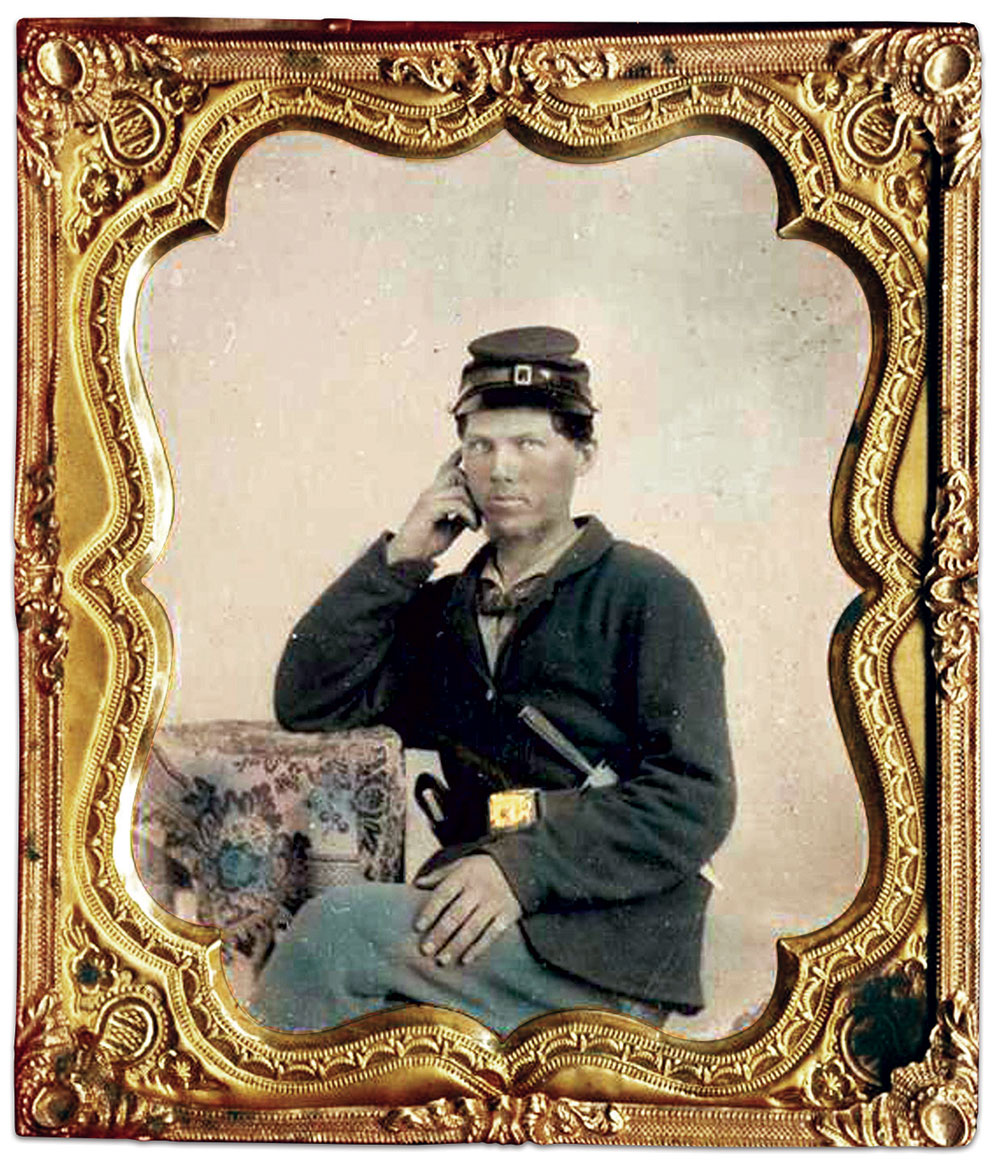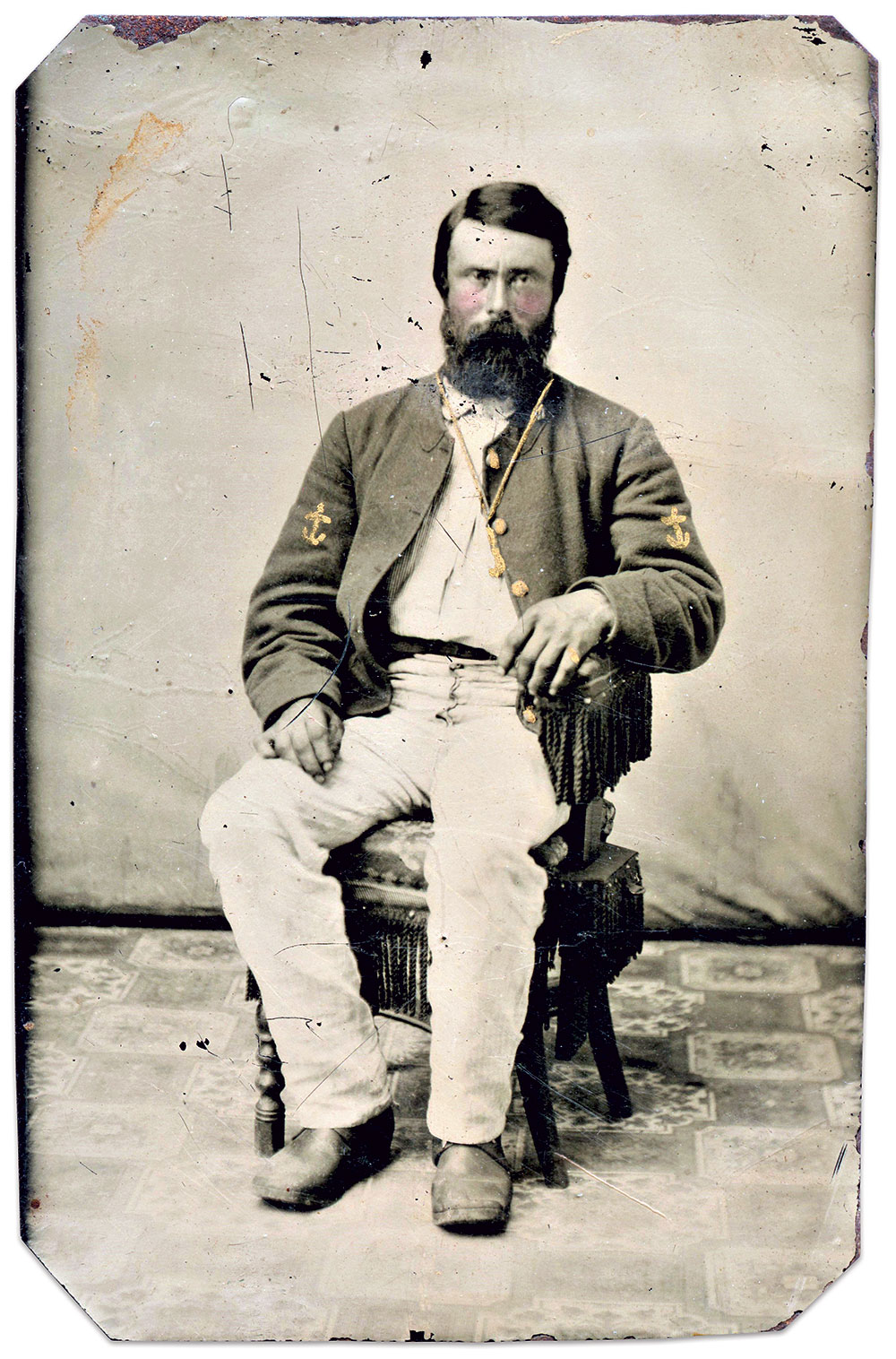By Perry Frohne
It is time we uncover the shenanigans collectors can run into when collecting Civil War hard images. I define “hard image” for the purpose of this column as Civil War tintypes and ambrotypes of all sizes and variations. This is the first of several planned columns in which I will give hard image collectors the information needed to detect any deception or fraud done to an image they have purchased or plan to buy.
The photographer’s original hand-tinted artistry
Collectors admire beautiful Civil War hard images they see in person, books and elsewhere—especially those that have been expertly hand-tinted by the photographer. Gently colored rouge cheeks or lips suggested an officer or soldier of substance. Sword hilts, buckles, buttons, watch chains, and medals and badges as well, were often tinted with color or gold gilding. Photographers found new ways to enhance hard images to appeal to the soldier, or the soldier’s family as a memento or remembrance for both sides of the battle lines.
Dirty deeds, done dirt cheap
Remember that wonderful period in the late 1980’s and early 1990’s when Civil War movies hit the big and small screens? First came Glory (1989), then Ken Burns’ PBS miniseries The Civil War (1990), and finally the glorious movie Gettysburg (1993). This four-year period created many new Civil War collectors. While a thriving (albeit modest) Civil War show circuit existed at that time, a number of the new collectors did not know that these shows existed. Where did you go back then to find antiques? Antique Malls and Shops!
Off they went searching for that authentic Civil War collectible to start or add to their budding collection. During the pre-internet days, those places became among the biggest retailers of fakes and frauds of all kinds.
It did not take long for those enterprising spawns of the devil who inhabited some of the malls to figure out how to create new inventory and cash in on the increasing demand and rising prices of Civil War collectibles. To generate traffic they had to keep their cases filled with “authentic” relics, including Confederate and Union hard images.
The problem: Authentic rebel hard images generated the most money and were not abundantly available. Fakers figured out a way to produce them without having to learn how to reproduce a complete ambrotype or tintype.
Fakers began buying Civil War era civilian hard images. They preferred ruby ambrotypes of men wearing military style civilian jackets of gray or a light color. These could be purchased for a few dollars each. Then, they painted colors appropriate to the type of unit and rank they wanted to fake (lots of gold, silver and blue). Very clever indeed.
The result: A new Confederate army.
How they did it
All fakers make mistakes. In this case, they went all out with gold paint and used it like they would never run out of it.
Here’s how they did it. The glass or tin plate would be removed from the case, and then gold paint applied by a fine brush was used to apply rank to lapels—one to three painted stars (not exact but close) or one to three bars on high collars. Touches of gold applied to buttons, belt buckles, sleeve braid and just about anywhere else covered the fact that this was a civilian image. Depending upon the skill of the con artist, or if the faker had an accomplice who was an artist, the finished product could appear impressive. Fortunately for us, they rarely found an artist.
To finish the job, the faker cleaned the glass and put it back after the paint dried. The new rebel was then put into a case at the antique mall, awaiting the unsuspecting buyer.
The internet came along soon after and this regional fraud turned international.
Golden glow—the real thing
Okay. We know the why and the how. Now, let’s become detectives and save money and a huge dose of aggravation.

The South Carolina soldier shown, courtesy of my friend Dan Schwab, is a genuine civil war ambrotype, professionally tinted as shown. Notice how you can still see the insignia on the buttons and belt buckle. His sleeve chevrons stand out and have no need for gold gilding. Take a good look.
If you see an image representing a Confederate, covered in gold paint, including areas of a uniform not normally painted gold, take time to pause. Give it a thorough visual inspection with at least a 10x loop. Can you see the outline of insignia anywhere near or underneath the gold, as with Dan’s image? You should at least see the outline of the sleeve braid if an officer or the collar insignia because the paint didn’t quite cover it, if it’s an authentic image. Confederate non-commissioned officers normally did not have sleeve insignia colored, as it was dark enough to stand out on its own.
Thankfully, very few of these fake images still circulate for sale all these years later. But some are still out there.
Bottom line: If it has more than a visually reasonable amount of gilding, trust your fake radar and inspect it thoroughly, or give it a pass.
Lord, it’s a miracle!
Here is one eyewitness account describing a civilian ambrotype turned into a confederate image. This was sent to me years ago for display on my website, modoc1873.com, as an example of what evil people were capable of.
“I’ve always collected Civil War hard images because I thought they were harder to fake but now I’m not so sure. I purchased an ambrotype last year because I thought the guy in the image might be military and I thought I might be able to pull something out on the buttons. I scan the image and couldn’t pull anything out on the buttons so I resold it last November on eBay for $20.

I was surprised this week when I saw the same image I sold but he had grown corporal stripes and cuff piping and the buttons are now gilded. The seller was the same guy I sold it to. I emailed him and he claims he doesn’t know how the image got altered and claims to have bought it at a gun show. The auction disappeared the next day. I’ve attached the scan I used when I sold the image and a jpg from the auction this past week. I hope you will add this to help educate others of the dangers of eBay.”
Thankfully, this story had at least a temporary happy ending.
In the Navy?
I think we’re on the same page with the magical paintbrush story. So, let’s turn our attention to Union hard plates.

First, the real deal. This authentic sixth plate tintype of a double-armed soldier comes courtesy of my friend Mike Medhurst. Notice how the gilding is applied a little heavy, but appears naturally on the belt buckle, and is not applied everywhere in an attempt to fancy up the soldier. Also notice the outstanding dark and light blue hand colored uniform. This is a great image in a full case.
Now have a look at this so-called Union image that comes to us courtesy of fellow Badger Jim Rivest. He purchased this through our favorite online auction ten years ago from a seller who described the man as a family member who served in the 8th Wisconsin Infantry. Knowing that the sleeve insignia was not army, but navy, Jim found an identification close to the original, but this name belonged to a rebel prisoner of war who had enlisted in the U.S. Navy in 1864.
An interesting and powerful story, right? A galvanized Yankee sailor? This should be worth a lot of money, right?

Jump forward 10 years. Jim and I were discussing this column, and he brought this photograph out and handed it to me. I immediately recognized it as doctored the moment I saw the poorly painted on navy insignia. Long before this time, Jim had decided the subject was neither an 8th Wisconsin Infantry soldier, nor a galvanized rebel navy sailor.
Piecing together the evidence, it appears this image started out as a civilian wearing light pants, a strange belt, striped shirt and sack coat with at least five buttons. After the application of paint, he was represented as a Confederate prisoner who voluntarily joined the Union navy. This concocted story having failed, a newly invented story portrayed him as a Wisconsin soldier.
Jim had put this image in the place all serious collectors put them—the drawer of shame. More on this subject will come in the future.
Be Careful Out There
As I’ve cautioned before, always take a very close look at any image you purchase. Do not feel rushed. Trust your fake radar. Purchase from trusted dealers that offer money back guarantees.
I don’t care what the story is behind an image. The truth lies in your hands.
Perry Frohne is the owner of Frohne’s Historic Military. He has been investigating fake images for more than 20 years. He is an MI Senior Editor.
SPREAD THE WORD: We encourage you to share this story on social media and elsewhere to educate and raise awareness. If you wish to use any image on this page for another purpose, please request permission.
LEARN MORE about Military Images, America’s only magazine dedicated to showcasing, interpreting and preserving Civil War portrait photography.
VISIT OUR STORE to subscribe, renew a subscription, and more.

